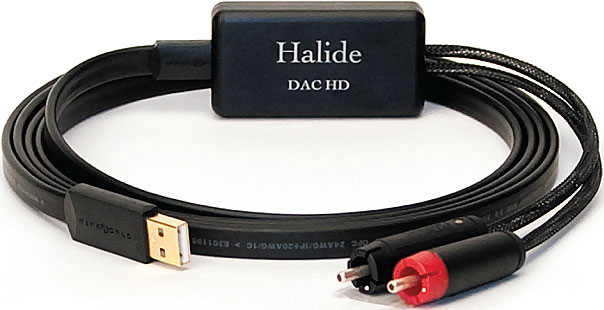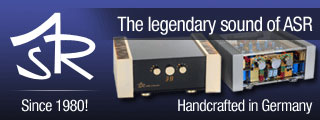
Halide’s new DAC HD comes hardwired with an attached, custom made one-meter Wireworld Starlight USB cable. A cable runs the power separately from the data lines, and features full coaxial shielding around the power lines. The output of the DAC connect to a pair of Pure silver analog RCA cables terminated with Eichmann silver bullet RCA connectors. The DAC itself is a diminutive 2 1/2 inches by 1 1/4 inches by 5/8 inches. It is encased in a black anodized, laser-engraved, custom-milled aluminum enclosure. The DAC HD is also cryogenically treated.
It features a new architecture, the same Streamlength™ asynchronous USB technology licensed from Wavelength Audio, found in their highly proclaimed Bridge, to transmit the USB data asynchronously to the device; this allows supposedly for playback of high-resolution audio files with ultra-low jitter. The DAC HD is a plug-and-play USB sound card, and is compatible with virtually everything. It’s manufactured lead-free, RoHS compliant in the USA. All Halide products are sold with a 60-day unconditional money back guarantee and a one-year warranty.
The actual digital-to-analog conversion in the HD is handled by the Wolfson WM8716. Halide Design says the WM8716 combines a number of desirable features in a D-to-A chip, such as being able to be programmed to use a “slow roll” digital interpolation filter. In listening tests, this results in a much more natural sound than the standard “fast roll-off” interpolation filter more commonly used in digital audio.
In response to a couple of questions I asked Jonathan Driscoll, President / CTO of Halide Design, he went on to say that you have to make trade-offs when voicing DACs: “voicing a DAC, there are inevitable trade offs – in this case, we used essentially a single ended circuit, which allowed us to build a very clear output stage, but may have technically higher THD and noise.”
I did most of my listening in my digital/video system, which is comprised of Teresonic Magus A55 speakers with Lowther Alnico A55 drivers; for amplification I used the Peachtree Audio Decco, and the sources were a Marantz Blu-Ray player and a Mac Mini with a Drobo. Nothing good be any easier than installing this DAC. I plugged the USB plug into my Mac Mini and the RCAs into the Decco integrated amp. All that was left was to select the USB output on the Mac and I had music.
Sound
How do I put this? Nothing prepared me for the sound of this little DAC. I had thought its main purpose would be to pair it with the LM Audio Mini 218 integrated amp as a headphone system. Don’t get me wrong, it does a great job in this setup, but it does so much more.
The Halide DAC HD replaced a very good sounding $2,000 DAC and USB converter combination that I was listening to, and blew away that combination. It’s a little hard to describe it’s greatest attribute in audiophile terms. That attribute is that the DAC HD is incredibly fun to listen to. It has a big sound that lets the midrange sound alive.
Yes, the soundstage is wide, deep, and even tall. Sure, the bass is full and satisfying, and the midrange is detailed and very voluptuous. Then, there’s the fact that the top-end is nicely extended, but not at all bright. Yes, all of that is true, but none of them explain why this thing makes my system so much fun to listen to.
I asked Jonathan how he got so much life out of such an inexpensive and simple looking DAC. He answered:
“I think one of the technologies that makes the DAC HD come alive is the absurdly low jitter. Nothing is ‘perfect,’ but it’s just way lower than most USB audio DACs out there, due not only to the fact that it’s asynch, but also that we just have a really nice clock circuit that we’ve been tweaking.
You can’t do really low jitter from a S/PDIF source, or rather you can, but it’s a completely different level of engineering. S/PDIF itself embeds jitter, and then you have to “fix” it later with reclocking, PLL’s buffers, etc. The USB asynch stuff lets you just plain skip this.”
I don’t understand that much about digital technology, but I feel Jonathan is really on to something with this design.
I guess in the name of full disclosure I should mention that I did try it downstairs in the reference system with $60,000 worth of preamp and amp, $15,000 speakers, and over $8,000 in cables. Well surprise, surprise. In this system, I could hear a few of the Halide’s faults. It sounded a little less refined than some of the mega-buck DACs I’ve had in this system. It also did not have the quietest backgrounds I have heard from those same mega-buck DACs. It still has the most lifelike midrange I have heard from any DAC under $2,000. No, I would not choose to use it in my reference system, but I should mention that I wouldn’t have any digital source in it either.
Conclusion
In a recent review of the $12,000 Audio Note CD-4.1X, Art Dudley said, “although its technology may not represent the state of the art of digital source components, the CD-4.1X stands as a reference-quality product in at least one regard: Any hobbyist who, like me, has found himself generally unsatisfied with the CD rank and file should go out of his or her way to hear it: It might be what you’re missing.”
I would say if you are like me and have generally found USB DACs and digital in general not to your liking, you need to hear the Halide DAC HD. There is really no reason not to, since it comes with a 60-day money back guarantee. I know this DAC isn’t the best DAC in the world. I know it’s not as good as the $40,000 DACs I have reviewed, but man it is fun to listen to. So, is the Halide DAC HD a giant slayer? Maybe or maybe not, but it may make you forget about the giant. The way it comes to life and how much fun it is to listen to is simply unbelievable. When’s the last time you heard me say that about any digital component?
- (Page 1 of 1)


